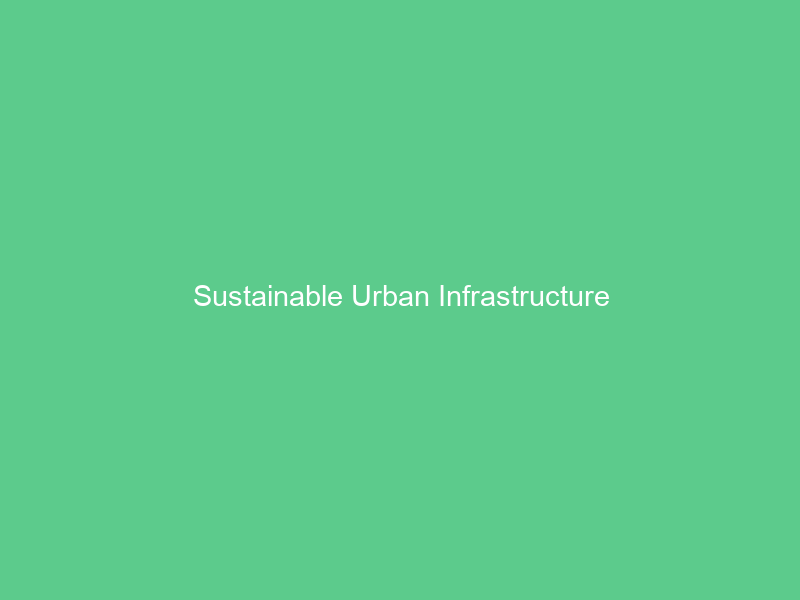Sustainable urban infrastructure involves creating eco-friendly and regenerative systems in cities. It fosters healthy living conditions, enhances public spaces, and fosters a sense of community.
Africa’s engagement with the Habitat Agenda took city-scale action seriously, yet was beset with fundamental problems such as service affordability and legitimate governance. This new material provides a methodology to explore innovative workable modes of provision within African cities.
Sustainability
Sustainable urban infrastructure is an integral element of climate action, building resilience in cities while mitigating and adapting to impacts from global warming. It incorporates eco-friendly practices into all facets of city infrastructure from buildings and transportation to waste management and water supply.
As part of a sustainable infrastructure solution, green spaces help reduce energy-consuming utilities. For instance, cities at risk of flooding could switch out concrete and tarmac streets with permeable paving that absorbs rainfall – helping mitigate flooding risks, protecting ecosystems, and improving air and water quality in turn.
An additional example is electric vehicle charging stations, which assist cities in increasing EV adoption and decreasing emissions. Furthermore, these initiatives can provide valuable data that can help improve sustainability of other infrastructure projects through cross-sector collaboration, education/training programmes and financial incentives to encourage use of green technologies.
Climate change
Cities are at the forefront of climate change as sources and destinations of materials and services, often connecting other urban areas through complex infrastructure systems that bind them. When one system malfunctions it could have significant repercussions in other connected ones – creating potentially hazardous consequences in an otherwise safe system.
Cities also face various barriers when it comes to taking climate action, including resource limitations and limited financial capacity for climate adaptation/resiliency projects. Their budgets often depend on transfers from national governments or revenue generated through taxes/fees (with some exceptions in developing nations).
One solution for addressing this challenge is investing in nature-based infrastructure like parks, green roofs and urban forests. Such green infrastructure solutions are cost-effective while offering environmental, social, economic and climate change resilience – as well as providing essential support to other sustainable infrastructure in a city.
Health and well-being
Sustainable urban infrastructure consists of public facilities like schools, hospitals and community centers that foster social and cultural well-being in cities. Additionally, this infrastructure includes renewable energy systems as well as waste management systems to eliminate or reduce pollutants. Sustainable road networks consist of paths designed for pedestrians and cyclists as well as lanes dedicated to public transportation; all helping reduce carbon emissions while simultaneously improving air quality.
Sustainable urban infrastructures enhance city resilience by mitigating climate change and adapting to its effects. Greensburg, Illinois, for instance, has transformed their concrete and tarmac areas into green, absorbent rain gardens to help minimize flooding caused by heavy rainfall.
Understanding infrastructure as a complex interconnected system reveals its relationships to other parts of a city or to nature worldwide, trade-offs between blue, brown and green infrastructure in providing ecosystem services, trade-offs among ecosystem services provisioned from each and the provision of ecosystem services themselves, as well as assumptions and values underlying infrastructure decision-making processes that impact health and sustainability outcomes.
Equity
Green infrastructure has become an increasing focus for cities as they seek to address environmental challenges and adapt to climate change impacts. Integrating natural elements into urban design to promote sustainability and enhance living conditions while simultaneously offering services such as air and water quality improvement, biodiversity support, climate regulation and carbon sequestration.
Urban nature provides social and health benefits for urban residents by providing access to nature, which has been shown to decrease feelings of stress and anxiety. Furthermore, it promotes physical activity through providing spaces for recreation.
Although sustainable urban development offers numerous advantages, its implementation can sometimes be limited by funding issues. One way of bridging this funding gap is incorporating non-bank lenders’ indices (NBI) into city planning and project assessments – using this approach can lower financial risks during pre-development stage so stakeholders can focus more on social and environmental aspects of project preparation.

